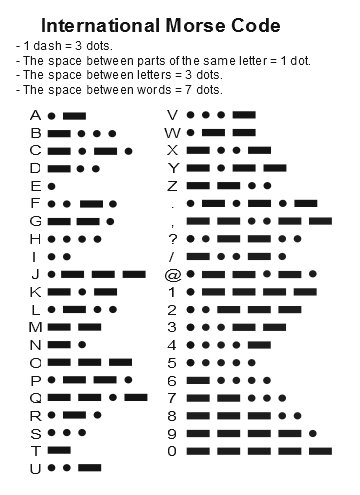| Learn Morse Code | |
|
Morse Code (CW) Handout |
| In 1836,
Samuel Morse demonstrated the ability of a telegraph system to
transmit information over wires. The information was sent as a
series of electrical signals. Short signals are referred to as
dits (represented as dots). Long signals are referred to as dahs
(represented as dashes). With the advent of radio
communications, an international version of Morse code became
widely used. The most well-known usage of Morse Code (CW) is for sending the distress signal: SOS. The SOS signal is sent as: Morse code relies on precise intervals of time between dits and dahs, between letters, and between words. Here's a chart that shows these relationships:
The speed of transmitting Morse code is measured in WPM (words per minute). The word "Paris" is used as the standard length of a word. To transmit the word "Paris" requires 50 units of time. If you transmitted the word "Paris" 5 times, you would be transmitting at 5 WPM. An experienced Morse code operator can transmit and receive information at 20-30 WPM. Below are severl zip files of a morse code course. Download the parts of the course you want to learn and unzip them to a folder on your computer. Each of the words files increase in difficulty from 2 letter words to sentences. The course was developed Chuck Adams K7QO.  |